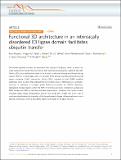Files in this item
Functional 3D architecture in an intrinsically disordered E3 ligase domain facilitates ubiquitin transfer
Item metadata
| dc.contributor.author | Murphy, Paul | |
| dc.contributor.author | Xu, Yingqi | |
| dc.contributor.author | Rouse, Sarah L. | |
| dc.contributor.author | Jaffray, Ellis G | |
| dc.contributor.author | Plechanovova, Anna | |
| dc.contributor.author | Matthews, Steve J. | |
| dc.contributor.author | Penedo, Carlos | |
| dc.contributor.author | Hay, Ronald T. | |
| dc.date.accessioned | 2020-07-31T09:30:02Z | |
| dc.date.available | 2020-07-31T09:30:02Z | |
| dc.date.issued | 2020-07-30 | |
| dc.identifier | 269137377 | |
| dc.identifier | e905c9df-a698-4067-b4db-123248c5b4f3 | |
| dc.identifier | 85088807112 | |
| dc.identifier | 000560053400016 | |
| dc.identifier.citation | Murphy , P , Xu , Y , Rouse , S L , Jaffray , E G , Plechanovova , A , Matthews , S J , Penedo , C & Hay , R T 2020 , ' Functional 3D architecture in an intrinsically disordered E3 ligase domain facilitates ubiquitin transfer ' , Nature Communications , vol. 11 , 3807 . https://doi.org/10.1038/s41467-020-17647-x | en |
| dc.identifier.issn | 2041-1723 | |
| dc.identifier.other | ORCID: /0000-0002-5807-5385/work/78204826 | |
| dc.identifier.uri | https://hdl.handle.net/10023/20381 | |
| dc.description | Funding: Wellcome Trust Investigator Awards (098391/Z/12/Z and 217196/Z/19/Z) and Cancer Research UK Programme grant (C434/A21747) to R.T.H., Wellcome Trust Studentship (109113/Z/15/Z) to P.M., Wellcome Trust Collaborative Award (215539) and multiuser equipment grant (104833) to S.J.M. Additionally J.C.P. thanks the Scottish Universities Physics Alliance (SUPA) and the University of St. Andrews for financial support. | en |
| dc.description.abstract | The human genome contains an estimated 600 ubiquitin E3 ligases, many of which are single-subunit E3s (ssE3s) that can bind to both substrate and ubiquitin-loaded E2 (E2~Ub). Within ssE3s structural disorder tends to be located in substrate binding and domain linking regions. RNF4 is a ssE3 ligase with a C-terminal RING domain and disordered N-terminal region containing SUMO Interactions Motifs (SIMs) required to bind SUMO modified substrates. Here we show that, although the N-terminal region of RNF4 bears no secondary structure, it maintains a compact global architecture primed for SUMO interaction. Segregated charged regions within the RNF4 N-terminus promote compaction, juxtaposing RING domain and SIMs to facilitate substrate ubiquitination. Mutations that induce a more extended shape reduce ubiquitination activity. Our result offer insight into a key step in substrate ubiquitination by a member of the largest ubiquitin ligase subtype and reveal how a defined architecture within a disordered region contributes to E3 ligase function. | |
| dc.format.extent | 13 | |
| dc.format.extent | 3290735 | |
| dc.language.iso | eng | |
| dc.relation.ispartof | Nature Communications | en |
| dc.subject | QH301 Biology | en |
| dc.subject | QH426 Genetics | en |
| dc.subject | DAS | en |
| dc.subject | BDC | en |
| dc.subject | R2C | en |
| dc.subject.lcc | QH301 | en |
| dc.subject.lcc | QH426 | en |
| dc.title | Functional 3D architecture in an intrinsically disordered E3 ligase domain facilitates ubiquitin transfer | en |
| dc.type | Journal article | en |
| dc.contributor.institution | University of St Andrews. School of Physics and Astronomy | en |
| dc.contributor.institution | University of St Andrews. Centre for Biophotonics | en |
| dc.contributor.institution | University of St Andrews. Biomedical Sciences Research Complex | en |
| dc.identifier.doi | 10.1038/s41467-020-17647-x | |
| dc.description.status | Peer reviewed | en |
This item appears in the following Collection(s)
Items in the St Andrews Research Repository are protected by copyright, with all rights reserved, unless otherwise indicated.

